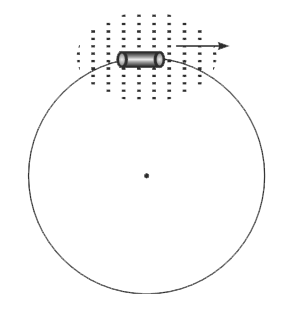A near surface earth’s satellite is rotating in equatorial plane from west to east. The satellite is exactly above a town at 6:00 A.M today. Exactly how many times will it cross ver the town by 6:00 A.M tomorrow. [Don’t count its appearance today at 6:00 A.M above the town].
The correct Answer is:16
Step by step video, text & image solution for A near surface earth’s satellite is rotating in equatorial plane from west to east. The satellite is exactly above a town at 6:00 A.M today. Exactly how many times will it cross ver the town by 6:00 A.M tomorrow. [Don’t count its appearance today at 6:00 A.M above the town]. by Physics experts to help you in doubts & scoring excellent marks in Class 11 exams.
Updated on:21/07/2023Topper's Solved these Questions
Similar Questions
An artificial satellite of the earth is to be established in the equatorial plane of the earth and to an observer at the equator it is required that the satellite will move eastward, completing one round trip per day. The distance of the satellite from the centre of the earth will be - ( The mass of the earth is 6.00×1024 kg and its angular velocity = 7.30×10−5rad/sec.)
View SolutionAssume the radius of the earth to be 6.4×106m
a. Calculate the time period T of a satellite on equational orbit at 1.4×10em above the surface of the earth.
b. What is the speed of the satellite in this orbit?
c. If the satellite is travelling in the same direction as the rotation of the earth i.e. west to east, what is the interval between two successie times at which it will appear vertically overhead to an observed at a fixed point on the equator?
View Solution
Knowledge Check
An artificial satellite of the earth is launched in circular orbit in the equatorial plane of the earth and the satellite is moving from west to east. With respect to a person on the equator, the satellite is completing one round trip in 24h. Mass of the earth is M=6×1024kg.For this situation the orbital radius of the satellite is
A2.66×104kmB6400kmC36,000kmD29,600kmA bell rings every 5 seconds. A second bell rings every 6 seconds and a third one rings every 8 seconds. If all the three rings at the same time at 8.00 a.m., at what time will they all ring together next?
A1 minute past 8.00 a.m.B2 minutes past 8.00 a.m.C3 minutes past 8.00 a.m.D4 minutes past 8.00 a.m.A table clock has its minute hand 5 cm long. Find the average velocity of the minute hand between 6:00 a.m. to 6:30 a.m.
A11×10−5m/sB5.5×10−5m/sC9×10−5m/sD18×105m/s
An artificial satellite is describing an equatorial orbit at 1600 km above the surface earth. Calculate its orbital speed and the period of revolution. If satellite is travelling in the same direction as the rotation of the earth (i.e., from west to east), calculate the interval between two successive time at wich it will appear verically overhead to an observer at a fixed point on the equator. Radius of earth = 6400 km.
View SolutionAn artificial satellite completes a circle around earth in 120 minutes. Calculate the height of the satellite above the earth's surface.
Take, radius of earth = 6,400 km
g=9.8m/s2
View SolutionAn artificial satellite is revolving in a circular orbit at a height of 600 km from the earth's surface. If its time of revolution be 100 minutes, calculate the acceleration due to gravity acting on it towards the earth. Radius of earth =6.4×106 m
View SolutionA near surface earth satellite has cylindrical shape with cross sectional area ofs=0.5M2 and mass of M = 10 kg. It encounters dust which has density of D=1.6XX10−11KG/ms. Assume that the dust particles are at rest and they stick to the satellite’s front face on collision. Take mean density of earth to beρ=5500kg/m3Find the drag force experienced by the satelliten
 If the dust extends throughout the orbit, find the change in velocity and radius of
the circular path of the satellite in one revolution.
If the dust extends throughout the orbit, find the change in velocity and radius of
the circular path of the satellite in one revolution.
View SolutionPotential energy of a satellite having mass m and rotating at a height of 6.4×106m from the earth surface is
View Solution
